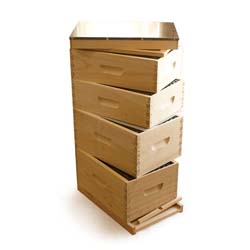Checking on your bees can be done during the colder months, but not in the same way you’d check them during a spring or summer beehive inspection. When temperatures are 40 degrees F or lower, you should avoid opening the hive whenever possible.
Disturbing the hive too much when it’s cold can distress honeybees and affect their ability to regulate heat within their winter cluster. Instead, you can safely check on your bees from the outside of their hive. Assess the bees’ location and status by knocking gently on the side of the beehive wall and listening closely (a stethoscope can help) to see if you hear buzzing. If bees are heard at the top of the hive, they may be toward the end of their food stores and could require emergency feed. Some beekeepers feel that knocking, even very gently, on the hive during the winter can potentially break the bees’ cluster, so take caution with this method.
If you must check on your bees during the winter months or add emergency feed, wait for a day that’s 50 degrees F or above, and do it as quickly as possible. Check for moisture buildup, issues with hive equipment, blocked hive entrances that need to be cleared, and take note of any signs that indicate bees may be suffering from dysentery.
Ensure beehives have proper insulation, ventilation, and food stores before winter to help aid in their survival, mitigate the risks to your bees, and lessen the need for intervention and disruption.
Read More
Checking Your Beehive Has Signs of Life
An Introduction to Overwintering Honeybees*
Preparing for a Deep and Long Winter *
* Colony Member-Only Content
